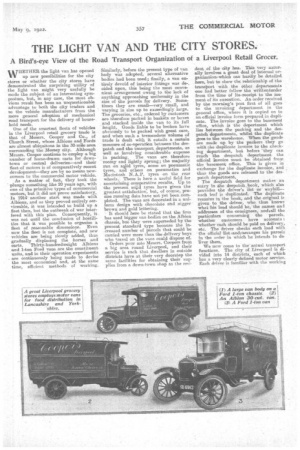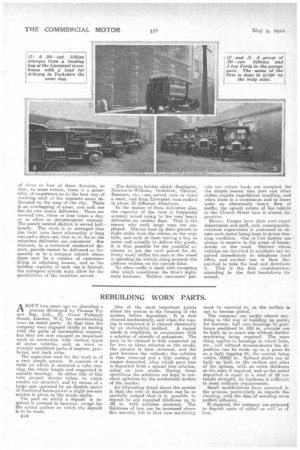THE LIGHT VAN AND THE CITY STORES.
Page 15

Page 16

If you've noticed an error in this article please click here to report it so we can fix it.
A Bird's-eye View of the Road Transport Organization of a Liverpool Retail Grocer.
WHETHER the light van has opened up new possibilities for the city stores or whether the city stores have demonstrated the surprising utility of the light van might very usefully be made the subject of an interesting 'symposium, but, in any case, the most, obvious result has been an unquestionable advantage to both the city traders and to the vehiele manufacturers from the more general adoption of mechanical road transport for the delivery of household needs.
One of the smartest fleets of vehicles in the Liverpool retail grocery trade is that of Messrs. Cooper and Co., of Church Street, whose Albions and Fords are almost ubiquitous in the 30-mile area surrounding the 'Mersey city. Although Messrs. 'Deeper continue to employ a big number of horse-drawn carts for downtown or central deliveries—and their fleet of motors is of comparatively recent development—they are by no means newcomers to the commercial motor vehicle.
As a Matter of face, they tack the plunge something like 20 years ago, with one of the primitive types of commercial motors, but it did not prove satisfactory. In 1914another start sees made with Albions, and as they proved entirely serviceable, it was intended to build up a fleet then, but the outbreak of war interfered with this plan. Consequently, it was not until the conclusion of hostilities that it was possible to organize a fleet of reasonable dimensions. Even now the fleet is not complete, and new vehicles are being slowly added, thus gradually displacing the horses and carts. Thirty-hundredweight ...klbions and 1-ton Feed visas are the constituent units, and in their operation experiments are continuously being made to devise the most economical and, at the seine time, efficient methods of working.
Similarly, before the present type of van body was adopted, several alternative bodies had been used; finally, a van entirely devoid of interior fittings was dee cided upore this being the most convenient arrangement owing to the lack of anything approaching uniformity in the size of the parcels for delivery. Sometimes they are small—very small, and varying in size up to exceedingly large. The groceries, etc., ordered Ity customers are therefore packed in baskets or boxes and stacked inside the van to its full height. Goods liable to be broken have obviously to be packed with peat care, and when suth a tremendous volume of trade is dealt with it entails a certain measure of co-operation between the despatch and the transport departments, as well as involving considerable expense in packing. The vans are therefore roomy and lightly sprung; the majority run on selid tyres, some on pneumatic tyres, ana others on pneumatics and Macintosh N.A.P. tyres on the rear wheels. There is hare a useful field for ascertaining comparative results. Up to the present soLid tyres have given the greatest satisfaction, but, of course, pre
cise data have not yet been completed. The vans are deoorated in a uniform 'design with chocolate end nigger brown and gold lettering.
It lhouid here be stated that the firm has used bigger van bodies on the Albion chassis, but they were superseded by the present standard type becente the increased number of parcels that could be carried were more then the delivery boys who travel on the vans could dispose of.
Orders pour mto Messrs. Coopers from a big area round Liverpool, and their service is such that dwellers in outside districts have at their very doorstep the same facilities for obtaining their supplies from a down-town shop as the reel dent, of the city has. This very naturally involves a great deal of internal organization-which can hardly be detailed, here, but to show the relationship of the transport with the other departments one had better follow the written (order from the time of it.sereceipt to the moment of its execution. An order received by the moriling's post first of all goes to the invoicing department in the genera/ office,, where it is copied on to an official invoice form prepared in duplicate. The invoice goes to the basement office, which is the department which lies between the packing and the despatch.depaatments, whilst the duplicate goes to the warehouse. When the goods are made up by the packers they go with the duplicate invoice to the ehecking department, but before they can reach the despatch department the official invoice must be obtained from the basement office. This is given in exchange for the duplicate invoice, and thus the goods are released to the despatch department. The despatch department makes an entry in the despatele,book, which also provides the driver's list OT waybill— each leaf is duplicated. The duplicate remains in the book, and the original is given to the driver, who thus knows what, his load should be, the names and addresses of the consignees, andlall the particulars concerning the parcels, whether customers have accounts ; whether cash should be paid an delivery, etc. The driver checks each load with the official list Pandtaaea,nges his parcels hi the order in which he intends to de. liver them.
We now conic to the'ateual transport functions. The city of Liverpool is divided into 14 districts each of which has a very clearly defined motor service. Each driver is familiar with the working of three or four of these districts, so that, to some extent, there is a generality of experience as to the best way ofcovering each of the separate areas delineated on the map of the city. There
.no overlapping of areas, and eadh one has its own motor deliveries. These are covered two, three oc four times a clay, or as often as aireternstances warrant. The purely eentral district is served half-hourly. The -work is so arranged that the local vans have alternately along run and a short one, that is, so far as the subuiban deliveries axe concerned. For instance, in a acattered residential district, parcels cannot be delivered so frequently as in a compact suburb where there may be a number of customers airing in adjoining houses, and as the holding oapacity of each van is limited, the transport systehs must allow for the peculiarities of the localities served. The districts farther afield—Southport, Newton-le. Willows, Ormskirk, Chester, Ituncore, etc.—are served once or twice a week, and from Liverpool saes radiate in about 25 different directions.
In the matter of these deliveries also, the rapacity of the vans is frequently sevexedy taxed owing to the very heavy deliveries .on certain days. That is the reason why such large vans are employed. Drivers load up their parcels in route order from the entries on the waybills, and Each of them having a boy to assist and aotually to deliver the goods, it is thus possible for the youthful assistant to get the nest parcel for delivery ready what the man at the wheel is speeding his vehicle along towards the address written on the outside 'abed.
No other traffic is dealt with excepting that which constitutes the firm's legitimate hominess. Neither customers' par
eels nor return loads are accepted, for the simple reason that post and other orders require expeditious handling, and w'hen there is a continuous and' attimes quite an sa.bnormally heavy flow of traffic, the speedy return of the vehicle to the Church Street base is almost imperative.
Messrs. Cooper have their own.repair department and staff, and, consequently, constant supervision is exercised to ensure each motor being kept in prime running condition. One or two motors are always in reserve in the event of break. downs on the road. Drivers -whose vehicles are involved in accidents are required immediately to telephone head office, and another van is then despatched to take the load and disteibute rt. This is the first consideration:, attending to the first breakdown thE second.




































